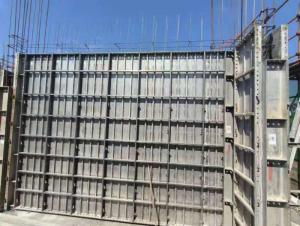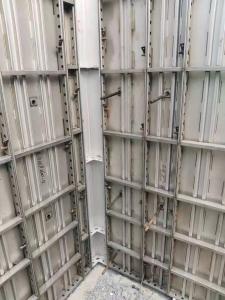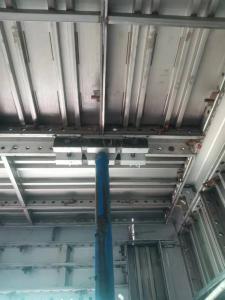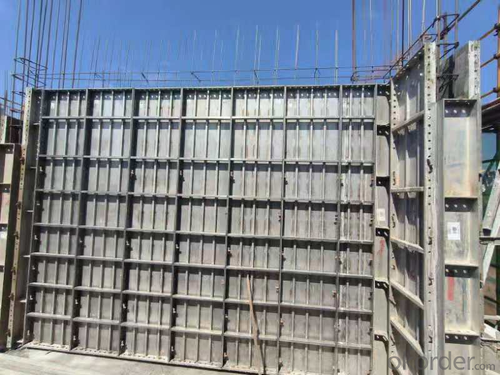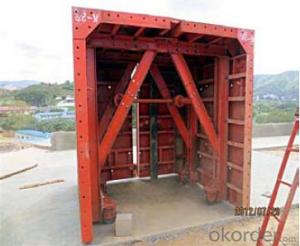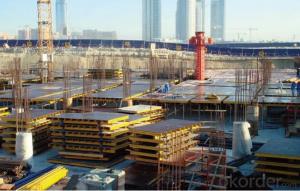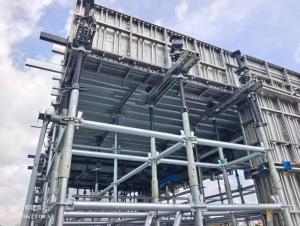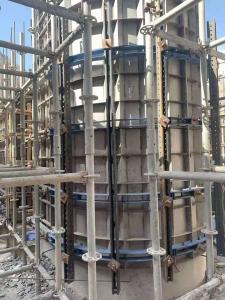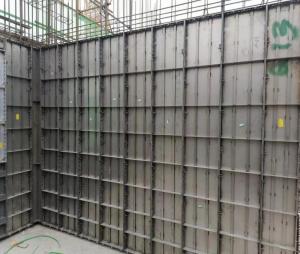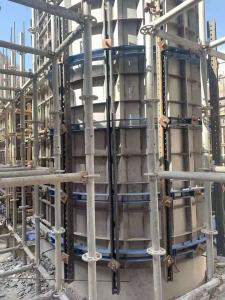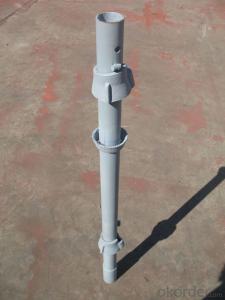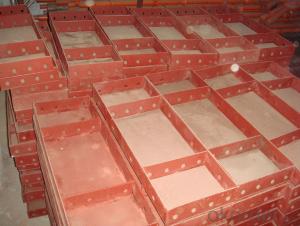High quality Support for concrete formwork Stainless Steel Formwork
- Loading Port:
- Shanghai
- Payment Terms:
- TT or LC
- Min Order Qty:
- 1 set
- Supply Capability:
- 1000000 set/month
OKorder Service Pledge
OKorder Financial Service
You Might Also Like
Replaceable size aluminum formwork :400X1200mm , 400X1500mm
Stainless steel formwork R&D background : committed to R&D and testing stainless steel formwork from material ,structure to processing technology for many years . Finally , a set of practical and lower cost perfect system has been developed .
Advantages:
1 Stainless steel formwork, 100% follow the design of aluminum alloy formwork system, it is interchangeable, compatible and can be used together with aluminum formwork at the same time .
2 (The maintenance of the floor or wall is simple and convenient, clean and smooth, easy to remove the mold, and the surface is beautiful.)
Integrated with the thermal insulation structure, the construction will be finished is fast, the efficiency is improved, no release agent is required, the wall has good flatness after de-moulding, no leveling is required, labor cost and time are saved . The construction speed of 5-6 floors a month shortens the construction period and saves Various expenses of the construction general contractor
3(The formwork is light in weight, loading capacity get higher , convenient in construction, high in strength, and stable in quality.)
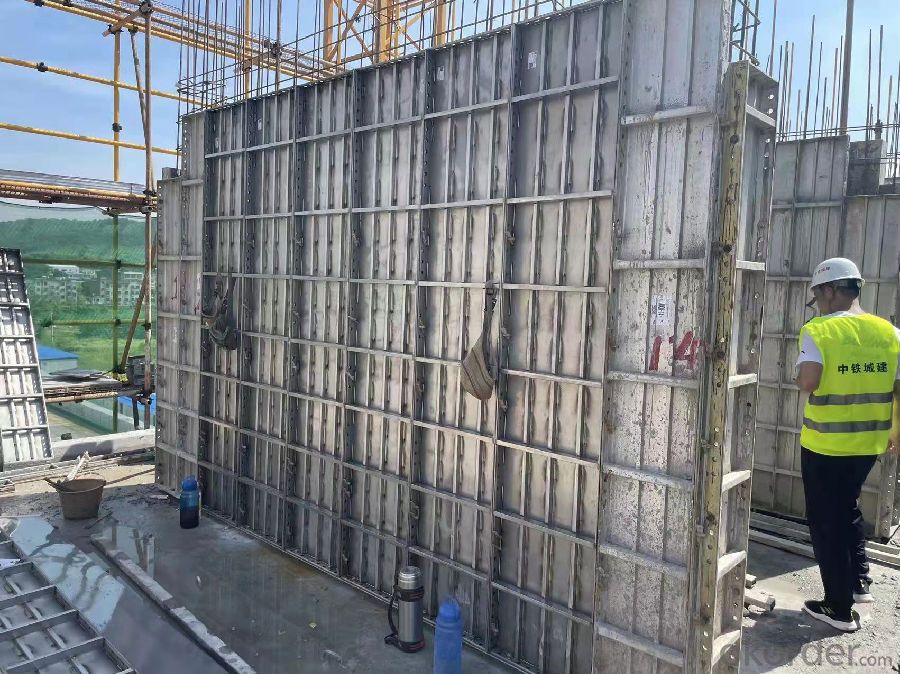
- Q: Can steel formwork be used for airport construction projects?
- Certainly, airport construction projects can make use of steel formwork. Steel formwork proves to be a versatile and long-lasting option when it comes to building various concrete structures within airports. Its attributes such as high strength, stability, and reusability offer multiple advantages, making it a suitable choice for extensive projects like airport construction. The robustness of steel formwork enables it to withstand the immense loads and pressures associated with airport infrastructure, thereby facilitating the construction of runways, taxiways, aprons, and other essential structures. Moreover, its modular design and flexibility allow for effortless customization and adaptation to cater to diverse project requirements. In summary, steel formwork emerges as a dependable selection for airport construction projects due to its durability, strength, and adaptability.
- Q: Can steel formwork be used in areas with high wind uplift forces?
- Yes, steel formwork can be used in areas with high wind uplift forces. Steel is a strong and durable material that can withstand high wind forces, making it suitable for use in such areas. Additionally, the rigid and stable nature of steel formwork provides added strength and stability, ensuring the structure remains intact even under extreme wind conditions.
- Q: How does steel formwork affect the overall constructability of the structure?
- The overall constructability of a structure is greatly enhanced by the use of steel formwork. Firstly, the high strength and durability of steel formwork enable it to withstand the pressure and forces exerted during the concrete pouring and curing process. This strength allows for the construction of taller and more complex structures, providing greater design flexibility. Furthermore, the reusability of steel formwork significantly reduces construction time and costs. Unlike traditional wooden formwork, steel formwork can be easily dismantled, cleaned, and reassembled for future concrete pours. This eliminates the need for continuous formwork fabrication, resulting in faster construction cycles and increased productivity. In addition, steel formwork ensures excellent dimensional accuracy and stability. The rigid structure of steel formwork allows for precise pouring and shaping of concrete according to desired dimensions, resulting in a more accurate and seamless end product. This accuracy is particularly important for high-quality construction, especially in critical elements such as walls, columns, and beams. Moreover, steel formwork offers superior surface finishes and better concrete quality. Its smooth and non-absorbent surface prevents water leakage or seepage from the concrete, resulting in a higher-quality finish. This is particularly beneficial for structures that require high aesthetic appeal or exposed concrete surfaces. Lastly, steel formwork enhances safety on construction sites. Its robust structure and stability reduce the risk of accidents during the concrete pouring and formwork removal processes. Steel formwork also allows for easier access and movement of workers, ensuring safe and efficient task performance. In conclusion, steel formwork significantly improves the constructability of structures. Its strength, reusability, dimensional accuracy, surface finish, and safety benefits make it a preferred choice for construction projects. By utilizing steel formwork, construction processes become more efficient, cost-effective, and reliable, resulting in a higher-quality end product.
- Q: Can steel formwork be used for architectural features?
- Yes, steel formwork can definitely be used for architectural features. Steel formwork is a versatile and durable construction material that is commonly used in various architectural applications. Its strength and rigidity make it suitable for creating complex and intricate architectural features such as columns, arches, beams, and decorative facades. Steel formwork provides excellent support and stability during the concrete pouring process, ensuring that the desired shape and design of architectural features are accurately achieved. Its high load-bearing capacity allows for the creation of large-scale architectural elements that might not be possible with other types of formwork materials. In addition to its structural benefits, steel formwork offers several advantages in terms of aesthetics. It can be easily molded and shaped to create unique and eye-catching architectural features. Steel formwork can also be customized with various surface finishes, textures, and patterns, providing architects with a wide range of design options to incorporate into their projects. Furthermore, steel formwork is highly reusable, making it a sustainable choice for architectural applications. Its durability allows for multiple uses, reducing waste and construction costs. This makes it a preferred choice for architects and contractors who value sustainability and cost-efficiency. Overall, steel formwork is an excellent choice for creating architectural features due to its strength, versatility, and aesthetic possibilities. Its ability to support complex designs and its sustainable nature make it a popular option in the construction industry.
- Q: How does steel formwork handle different concrete early age strength development?
- Steel formwork is a versatile and durable material that is commonly used in construction for shaping and supporting concrete structures. When it comes to handling different concrete early age strength development, steel formwork demonstrates several advantages. Firstly, steel formwork provides excellent support and stability to the concrete during the initial stages of its curing process. This is crucial as the concrete gains strength and begins to harden. The rigid nature of steel formwork prevents any deformation or displacement, ensuring that the concrete retains its desired shape and structure as it sets. Additionally, steel formwork offers a high level of dimensional accuracy. This means that it can provide precise and consistent shapes and sizes to the concrete elements being constructed. This is particularly important during the early age strength development phase, as any variations or inconsistencies in the formwork could negatively impact the overall strength and integrity of the concrete. Furthermore, steel formwork is highly resistant to moisture and chemical reactions. Concrete undergoes a hydration process, where it absorbs water and undergoes chemical reactions to gain strength. Steel formwork, being non-absorbent, prevents excessive moisture from being absorbed by the concrete, which could lead to reduced strength development or even cracking. Additionally, steel formwork does not react chemically with the concrete, ensuring that the desired early age strength development is not compromised. Another advantage of steel formwork is its reusability. Unlike other formwork materials such as wood or plastic, steel formwork can be easily dismantled and reused for multiple construction projects. This not only reduces construction costs but also allows for consistent and reliable formwork performance, regardless of the concrete's early age strength development requirements. In conclusion, steel formwork is a reliable and efficient solution for handling different concrete early age strength development. Its stability, dimensional accuracy, resistance to moisture and chemical reactions, as well as its reusability, make it an ideal choice for shaping and supporting concrete structures during the crucial initial stages of curing.
- Q: How is steel formwork removed after concrete has cured?
- Typically, steel formwork is taken down in a systematic manner once the concrete has fully cured. The first step involves removing any props or supports that were utilized during the pouring and curing process. These supports are usually adjustable and can be easily taken apart. Next, a thorough inspection of the formwork panels is conducted to ensure that the concrete has completely cured and is ready to be detached. Once this confirmation is made, the formwork panels are disconnected from one another, starting at the top and working downwards. To dismantle the formwork, specialized tools like formwork wedges or clamps are typically used to release the connections between the panels. These connections are usually designed to be easily disassembled, allowing for efficient removal. After the panels are disconnected, they are carefully lifted away from the cured concrete using cranes, forklifts, or other lifting equipment, depending on their size and weight. During the removal process, great care must be taken to prevent any damage to the concrete structure. The formwork panels are lifted with caution, ensuring that they do not scrape or impact the concrete surface. Additionally, any residue or debris that may have accumulated on the formwork panels during the curing process should be cleared away before lifting them. Once the steel formwork is entirely removed, it can be stored for future use or disassembled for recycling. Proper storage and maintenance of the formwork are crucial to ensure its longevity and cost-effectiveness for future construction projects. In conclusion, the systematic removal of steel formwork following concrete curing involves the careful disassembly and lifting of the formwork panels. By following these steps, the integrity of the concrete structure is maintained, while allowing for the reuse or recycling of the formwork.
- Q: What are the considerations when designing steel formwork for underground parking structures?
- When designing steel formwork for underground parking structures, there are several important considerations that need to be taken into account. These considerations include: 1. Structural Stability: Underground parking structures experience significant loads from the surrounding soil, as well as the weight of the vehicles they will accommodate. It is crucial to design the steel formwork in a way that ensures structural stability and can withstand these loads. 2. Water Resistance: Underground parking structures are susceptible to water infiltration, especially in areas with high groundwater levels. The steel formwork should be designed to be watertight, with proper sealing and waterproofing measures in place, to prevent water damage and maintain the integrity of the structure. 3. Fire Resistance: Fire safety is of utmost importance in underground parking structures. The steel formwork should be designed to meet the required fire resistance standards and provide adequate protection against fire hazards. 4. Durability: Underground parking structures are subject to constant traffic and wear and tear. The steel formwork should be designed to be durable and able to withstand the load and stress imposed by vehicles, as well as any potential impact from collisions or accidents. 5. Accessibility and Efficiency: The design of the steel formwork should take into consideration the accessibility of the parking structure, including the layout of ramps, entrances, and exits. It should also aim to maximize space utilization and efficiency, providing adequate parking slots without compromising safety or ease of use. 6. Maintenance and Repairs: The design should also consider the ease of maintenance and repairs. Accessible areas for inspection, maintenance, and repairs should be incorporated into the formwork design to ensure that any necessary maintenance or repairs can be carried out efficiently. 7. Cost-effectiveness: Finally, the design should strike a balance between meeting all the necessary requirements and being cost-effective. It is essential to consider the overall cost of materials, construction, and maintenance when designing the steel formwork for underground parking structures. By carefully considering these considerations, engineers and designers can create effective and efficient steel formwork for underground parking structures that meet all the necessary requirements for safety, durability, and functionality.
- Q: Is steel formwork suitable for all types of concrete structures?
- Steel formwork is generally considered to be suitable for a wide range of concrete structures. However, its suitability may depend on several factors such as the design requirements, budget, and project timeline. Steel formwork offers several advantages over other types of formwork systems. It is known for its high strength and durability, which allows it to withstand the pressure exerted by the fresh concrete without warping or deforming. This makes it particularly suitable for structures that require large concrete pours or have complex geometries. Moreover, steel formwork provides excellent dimensional accuracy, ensuring that the final concrete structure meets the required specifications. It also allows for easy customization, enabling the formwork to be tailored to the specific needs of the project. However, there are instances where steel formwork may not be the most suitable option. For example, if the budget is limited, steel formwork may be more expensive compared to alternatives such as timber or plastic formwork. Additionally, if the project has a tight schedule, steel formwork may require more time for fabrication and assembly compared to other systems. Furthermore, steel formwork may not be the best choice for structures that have strict aesthetic requirements. The steel panels may leave imprints on the concrete surface, which may not be desirable in certain architectural designs. In conclusion, while steel formwork is generally suitable for a wide range of concrete structures, its suitability may vary based on project-specific factors such as design requirements, budget, and timeline. It is important to carefully evaluate these factors before deciding on the most appropriate formwork system for a particular project.
- Q: How does steel formwork affect the overall acoustic properties of the structure?
- The overall acoustic properties of a structure are not significantly affected by steel formwork. Steel formwork refers to temporary structures made of steel panels that are used to hold concrete in place during construction. Once the concrete has hardened, these formwork systems are typically removed. The materials used in permanent construction elements, such as walls, floors, and ceilings, primarily determine the acoustic properties of a structure. Since steel formwork is not a permanent part of the structure, it does not contribute to its acoustic properties. However, it is important to acknowledge that steel formwork can create temporary noise and vibrations during the construction process. This is due to the handling of the steel panels and the pouring and compacting of concrete. These construction activities can generate noise that may affect the acoustic environment near the construction site. However, once the formwork is removed and the structure is finished, the steel formwork itself does not have a significant impact on the overall acoustic properties of the building.
- Q: Can steel formwork be used for projects with high concrete durability demands?
- Yes, steel formwork can be used for projects with high concrete durability demands. Steel formwork is renowned for its strength, stability, and ability to withstand repeated use. It provides a smooth and even surface finish to the concrete, ensuring high-quality results. Additionally, steel formwork is resistant to warping or distortion, which can affect the durability of the concrete structure. Thus, it is a reliable choice for projects that require high concrete durability.
Send your message to us
High quality Support for concrete formwork Stainless Steel Formwork
- Loading Port:
- Shanghai
- Payment Terms:
- TT or LC
- Min Order Qty:
- 1 set
- Supply Capability:
- 1000000 set/month
OKorder Service Pledge
OKorder Financial Service
Similar products
Hot products
Hot Searches
